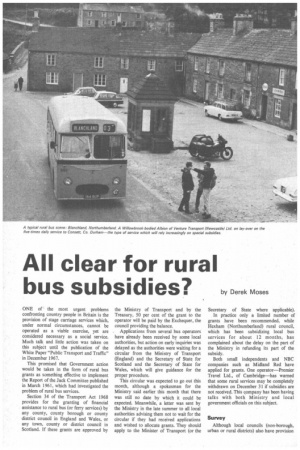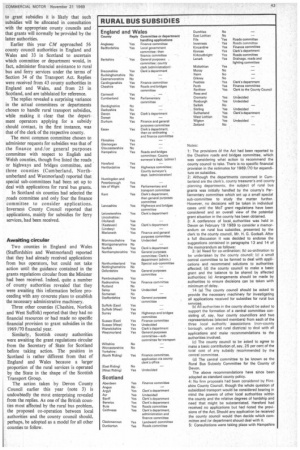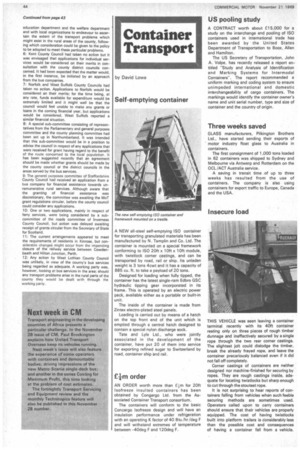All clear for rural
Page 44

Page 45

Page 46

If you've noticed an error in this article please click here to report it so we can fix it.
bus subsidies? by Derek Moses
ONE of • the most urgent problems confronting country people in Britain is the provision of stage carriage services which, under normal circumstances, cannot be operated as a viable exercise, yet are considered necessary as a social service. Much talk and little action was taken on this subject until the publication of the White Paper "Public Transport and Traffic" in December 1967.
This promised that Government action would be taken in the form of rural bus grants as something effective to implement the Report of the Jack Committee published in March 1961, which had investigated the problem of rural bus services.
Section 34 of the Transport Act 1968 provides for the granting of financial assistance to rural bus (or ferry services) by any county, county borough or county district council in England and Wales, or any town, county or district council in Scotland. If these grants are approved by the Ministry of Transport and by the Treasury, 50 per cent of the grant to the operator will be paid by the Exchequer, the council providing the balance.
. Applications from several bus operators have already been received by some local authorities, but action on early inquiries was delayed as the authorities were waiting for a circular from the Ministry of Transport (England) and the Secretary of State for Scotland and the Secretary of State for Wales, which will give guidance for the proper procedure.
This circular was expected to go out this month, although a spokesman for the Ministry said earlier this month that there was still no date by which it could be expected. Meanwhile, a letter was sent by the Ministry in the late summer to all local authorities advising them not to wait for the circular if they had received applications and wished to allocate grants. They should apply to the Minister of Transport (or the Secretary of State where applicable).
In practice only a limited number of grants have been recommended, while Hexham (Northumberland) rural council, which has been subsidizing local bus services for about 12 months, has complained about the delay on the part of the Ministry in refunding its part of the subsidy.
Both small independents and NBC companies such as Midland Red have applied for grants. One operator—Premier Travel Ltd., of Cambridge—has warned that some rural services may be completely withdrawn on December 31 if subsidies are not received. This company has been having talks with both Ministry and local government officials on this subject.
Survey Although local councils (non-borough, urban or rural districts) also have provision to .grant subsidies it is likely that such subsidies will be allocated in consultation with the appropriate county councils and that grants will normally be provided by the latter authorities.
Earlier this year CM approached 56 county council authorities in England and Wales and 33 in Scotland to ascertain which committee or department would, in fact, administer financial assistance to rural bus and ferry services under the terms of Section 34 of the Transport Act Replies were received from 43 county authorities in England and Wales, and from 25 in Scotland, and are tablulated for reference.
The replies revealed a surprising variance in the actual committees or departments chosen to handle rural transport subsidies, while making it clear that the department operators applying for a subsidy should contact, in the first instance, was that of the clerk of the respective county.
The most common committee chosen to administer requests for subsidies was that of the finance and/or general purposes committee with respect to English and Welsh counties, though five listed the roads or highways and bridges committee, and three counties (Cumberland, Northumberland and Westmorland) reported that special sub-committees had been set up to deal with applications for rural bus grants.
In Scotland six counties had selected the roads committee and only four the finance committee to consider applications. Inverness County Council reported that applications, mainly for subsidies for ferry services, had been received.
Awaiting circular Two counties in England and Wales (Staffordshire and Westmorland) reported that they had already received applications from bus operators, but could not take action until the guidance contained in the grants regulations circular from the Minister had been received. Indeed, quite a number of county authorities revealed that they were awaiting this information before proceeding with any concrete plans to establish the necessary administrative machinery.
Three other counties (Cheshire, Norfolk and West Suffolk) reported that they had no financial resources or had made no specific financial provision to grant subsidies in the 1969 /70 financial year.
Similarly, Scottish county authorities were awaiting the grant regulations circular from the Secretary of State for Scotland before taking action. The position in Scotland is rather different from that of England and Wales because a larger proportion of the rural services is operated by the State in the shape of the Scottish Transport Group.
The action taken by Devon County Council earlier this year (note 3) is undoubtedly the most enterprising revealed from the replies. As one of the British coun ties most affected by the rural bus problem, the proposed co-operation between local authorities and the county council should, perhaps, be adopted as a model for all other counties to follow_
Notes: 1: The provisions of the Act had been reported to the Cheshire roads and bridges committee, which was considering what action to recommend the county council to take. There is no specific financial provision in the estimates for 1969 /70 for expenditure on subsidies.
2: Although the departments concerned in Cumberland are the clerk's. county treasurer's and county planning departments, the subject of rural bus grants was initially handled by the county's Parliamentary committee which set up a small special sub-committee to study the matter further. However, no decisions will be taken in individual cases until the MoT grant regulations have been considered and an overall view of the potential grant situation in the county has been obtained.
3: A conference of local, authorities was held in Devon on February 19 1969 to consider a memorandum on rural bus subsidies, presented by the clerk to the county council, Mr. H. G. Godsall. After a full discussion it was decided to endorse the suggestions contained in paragraphs 13 and 14 of the memorandum as follows: 3: (al Need for co-ordination; (b) co-ordination to be undertaken by the county council; (c) a small central committee to be formed to deal with applications and recommend solutions to authorities affected; (d) the county council to make a basic grant and the balance to be shared by affected authorities; le) Arrangements should be made by authorities to ensure decisions can be taken with minimum of delay.
14 (a) The county council should be asked to provide the necessary machinery for investigating ail applications received for subsidies for rural bus services.
)b) All authorities in the county should be asked to
support the formation of a central committee consisting of, say, four county councillors and two representatives (elected members) from each of the three local authority ' associations Mon-county
• borough, urban and rural districts} to deal with all applications and make recommendations to the authorities involved.
Icl The county council to be asked to agree to make a basic contribution of, say, 25 per cent of the total cost of any subsidy recommended by the central committee.
(d) The central committee to be known as the Rural Bus Subsidy Committee for the County of Devon.
The above recommendations have since been adopted as standard county policy.
4: No firm proposals had been considered by Flintshire County Council, though the whole question of subsidized-transport would be considered bearing in mind the powers of other local authorities within the county and the relative degrees of hardship and need that might be substantiated. Hereford had received no applications but had noted the provisions of the Act. Should any application be received the county council would then decide which committee and for department should deal with it.
5: Consultations were taking place with Hampshire
education department and the welfare department and with local organizations to endeavour to ascertain the extent of the transport problems which might exist in the rural areas of the county, following which consideration could be given to the policy to be adopted to meet these particular problems.
6: Kent County Council had taken no action but it was envisaged that applications for individual services would be r considered on their merits in consultation with the county district councils concerned. It had been expected that the matter would, in the first instance, be initiated by an approach from the bus companies.
7: Norfolk and West Suffolk County Councils had taken no action. Applications to Norfolk would be considered on their merits; for the time being, at any rate, funds available for expenditure would be extremely limited and it might well be that the council would feel unable to make any grants or loans in the coming financial year, but applications would be considered. West Suffolk reported a similar financial situation.
8: A special sub-committee consisting of representatives from the Parliamentary and general purposes committee and the county planning committee had been set up in Northumberland. It was intended that this sub-committee would be in a position to advise the council in respect of any applications that were received for grant having regard to the benefit of the route concerned to the local population . It has been suggested recently that an agreement should be made whether grants should be made by the county council or the district councils in the areas served by the bus services.
9: The general purposes committee of Staffordshire County Council had received an application from a bus company for financial assistance towards unremunerative rural services. Although aware that the granting of financial assistance was discretionary, the committee was awaiting the MoT grant regulations circular, before the county council could consider any applications.
10: One or two applications, mainly in respect of ferry services, were being considered by a subcommittee of the roads committee of Inverness County Council, but action was delayed awaiting receipt of grants circular from the Secretary of State for Scotland.
11: The current arrangements appeared to meet the requirements of residents in Kinross, but considerable changes might occur from the impending closure of the railway service between Cowdenbeath and Hilton Junction, Perth.
12: Any action by West Lothian County Council was unlikely, in view of the county's bus services being regarded as adequate. A working party was, however, !coking at bus services in the area; should any transport problems arise in the rural parts of the county they would be dealt with through the working party.
A NEW all-steel self-emptying ISO container for transporting granulated materials has been manufactured by N. Tamplin and Co. Ltd. The container is mounted on a special framework conforming to ISO 20ft x 10ft x 10ft module, with twistlock corner castings, and can be transported by road, rail or ship. Its unladen weight is 3 tons 4cwt and it has a capacity of 885 Cu. ft. to take a payload of 20 tons.
Designed for loading when fully tipped, the container has the latest single-ram Edbro GSC hydraulic tipping gear incorporated in its frame. This is operated by an electric power pack, available either as a portable or built-in unit.
The inside of the container is made from Zintex electro-plated steel panels.
Loading is carried out by means of a hatch on the top front end of the unit which is emptied through a central hatch designed to Contain a special nylon discharge sock.
Tate and Lyle Ltd., who were jointly associated in the development of the container, have put 20 of them into service for exporting refined sugar to Switzerland by roan, container ship and rail.
flm order AN ORDER worth more than f_'!im for 20ft lsofreeze insulted containers has been obtained by Congargo Ltd. from the Associated Container Transport consortium.
The containers will conform to the basic Concargo Isofreeze design and will have an insulation performance under refrigeration with an operating K factor of 40 Btu /hr /deg F and will withstand extremes of temperature between --40deg F and 120deg F.
US pooling study
A CONTRACT worth about £15,000 for a study on the interchange and pooling of ISO containers used in international trade has been awarded by the United States Department of Transportation to Boos, Allen arid Hamilton.
The US Secretary of Transportation, John A. Volpe, has recently released a report entitled "Study and Analysis of Identification and Marking Systems for Intermodal Containers-. The report recommended a uniform marking and coding system to ensure unimpeded international and domestic interchangeability of cargo containers. The markings would identify the container owner's name and unit serial number, type and size of container and the country of origin.
Three weeks saved
GLASS manufacturers, Pilkington Brothers Ltd., have started sending their exports of motor industry float glass to Australia in containers.
The first consignment of 1,000 tons loaded in 62 containers was shipped to Sydney and Melbourne via Antwerp and Rotterdam on the OCL /ACT Australia service.
A saving in transit time of up to three weeks has resulted from the use of containers. The company is also using containers for export traffic to Europe, Canada and the USA.
THIS VEHICLE was seen leaving a container terminal recently with its 40ft container resting only on three pieces of rough timber dunnage and ineffectively secured by a single rope through the two rear corner castings. The slightest jolt could dislodge the timber, break the already frayed rope, and leave the container precariously balanced even if it did not fall off completely.
Corner castings of containers are neither designed nor machine-finished for securing by ropes. They are rough castings inside, adequate for locating twistlocks but sharp enough to cut through the stoutest rope.
It is not surprising to hear reports of containers falling from vehicles when such feeble securing methods are sometimes used. Operators called upon to carry containers should ensure that their vehicles are properly equipped. The cost of having tvvistlocks built into platform trailers is Considerably less than the possible cost and consequences of having a container fall from a vehicle.




































































































